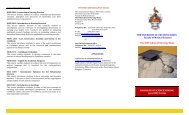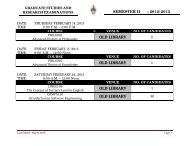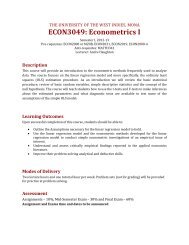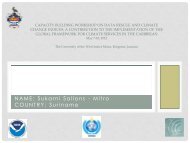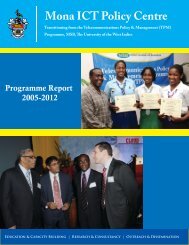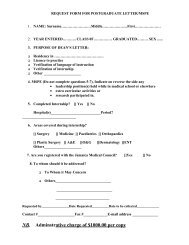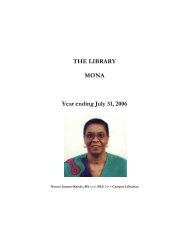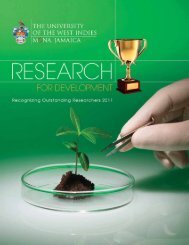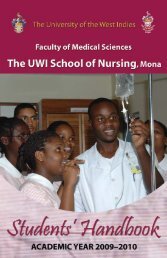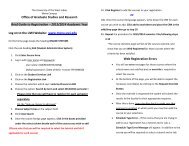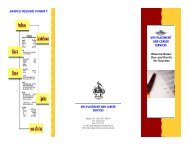Hyacinth Harding-Goldson, Marvin Reid & Richard Augier - Uwi.edu
Hyacinth Harding-Goldson, Marvin Reid & Richard Augier - Uwi.edu
Hyacinth Harding-Goldson, Marvin Reid & Richard Augier - Uwi.edu
- No tags were found...
You also want an ePaper? Increase the reach of your titles
YUMPU automatically turns print PDFs into web optimized ePapers that Google loves.
5 2<br />
U W I R E S E A R C H F O R D E V E L O P M E N T 2 0 1 3<br />
T R O P I C A L M E D I C I N E R E S E A R C H I N S T I T U T E<br />
D E P A R T M E N T O F S U R G E R Y , R A D I O L O G Y , A N A E S T H E S I A & I N T E N S I V E C A R E<br />
<strong>Hyacinth</strong> <strong>Harding</strong>-<strong>Goldson</strong>,<br />
<strong>Marvin</strong> <strong>Reid</strong> & <strong>Richard</strong> <strong>Augier</strong><br />
Urinary Leukotriene E4 in<br />
Patients with Homozygous<br />
Sickle Cell Disease
U W I R E S E A R C H F O R D E V E L O P M E N T 2 0 1 3<br />
Sickle populations cell in disease tropical predominantly and sub-tropical affects<br />
and their descendants in the Americas Africa leukotriene<br />
Europe but also occurs in populations from and which E4 (LTE4) is a metabolic by- product<br />
of can be measured in the urine. Discovery<br />
the Jamaica Mediterranean, has a relatively the Middle high East, prevalence and India. E4 an association between urinary leukotriene<br />
sickle cell disease (SCD), which accounts for of support (uLTE4) levels and acute painful crisis would<br />
disease the use of uLTE4 as a biomarker of<br />
1:150 genetic births variation (approx 300/year). which there It is is an production inherited of severity (in terms of frequency of episodes<br />
possible APC) and therapy use for of APC. leukotriene inhibitors as a<br />
of The abnormal haemoglobin haemoglobin S molecule S in crystalises red blood when cells. Pain<br />
exposed in a conformational to low oxygen change concentrations in the shape resulting be affects all persons with the disease. It can<br />
blood cells from their normal biconcave, round of red chronic acute, chronic or acute on a background of<br />
a pain and often is severe as to have<br />
shape increased to crescents fragility of called the red ‘sickling’. blood cells, This increased results lives. destructive socio-economic impact on their<br />
episodes People who suffer from frequent painful<br />
destruction results in a and low a shortened red blood life cell span. count The called latter missing are often stigmatized because of often<br />
pain- work or school and requiring strong<br />
anaemia. blood vessels Sickling with also impaired causes blood blockage supply. of There small acute relieving drugs. Approximately 50 cases of<br />
Sickle painful crisis are managed monthly at the<br />
is from also damage inflammation to their of lining the blood and activation vessels resulting at cell unit and another 30 cases are seen<br />
body’s immunological/hormonal stress response. of the Casualty the University Hospital of the West Indies<br />
healthcare Department, placing additional<br />
Blockage starved of of oxygen blood vessels, resulting leads in tissue to tissues death being overburdened requirements service. on an already<br />
more commonly in severe and debilitating pain. but Presently that there is only one treatment<br />
Patients painful crises with (APC). sickle cell These disease involve suffer the extremities, from acute of can r<strong>edu</strong>ce the frequency<br />
drug acute painful crisis, and this<br />
pelvis, leukotrienes abdomen, (CysLT) chest are inflammatory and back. molecules Cysteinyl patients, cannot be used in all<br />
for so the search<br />
produced 5-lipooxygenase from pathway. arachidonic There acid is evidence through that the continues. other treatments<br />
CysLT- of occlusion related of vascular blood effects vessels may in SCD. be the Cysteinyl cause<br />
5 3
5 4<br />
A method biomarker of measuring that could be the used severity as an of objective<br />
and the level of pain would allow for disease<br />
targeted care, and help to reverse common more<br />
misperceptions. useful in improving Such the a standard tool would of care be extremely<br />
to persons with sickle cell disease available<br />
extension the quality and productivity and of their by<br />
lives. the inflammatory This project molecules investigates Cysteinyl the possibility leukotrienes that<br />
(CysLT) could be one such biomarker.<br />
Cysteinyl have been leukotrienes<br />
in the pathophysiology implicated<br />
of constriction asthma. They of cause<br />
pulmonary blood the<br />
vessels, mucous secretion increase<br />
and vascular permeability. pulmonary<br />
The the association discovery has of<br />
resulted leukotriene in the inhibitors use of<br />
in asthmatic management patients. of<br />
A related demonstrated painful episodes association and uLTE4 between will suggest sicklea<br />
in possible SCD patients, application and allow of leukotriene for measurement inhibitors<br />
the relationship between dose and effect. This of<br />
would of leukotriene allow for inhibitors future investigations as therapy for into sickle the use<br />
pain.<br />
cell<br />
This concentration experimental in patients study investigates with homozygous uLTE4<br />
sickle no pain cell and disease during during painful periods episode. when It comprises they have<br />
of three phases:<br />
Phase An experimental 1<br />
patients with homozygous study comparing SCD during uLTE4 steady in<br />
state controls. with age and gender matched HbAA<br />
Phase An 2<br />
study experimental<br />
steady state comparing<br />
of uLTE4 in levels<br />
groups of patients two<br />
with SCD. Group homozygous<br />
with a history 1, those<br />
“high frequency” of of a<br />
APCs and group (>5/year, 2, those high)<br />
who frequency” have (
Collaborators: Professor UWI, Mona. <strong>Marvin</strong> <strong>Reid</strong>, Director, Sickle Cell Unit,<br />
Dr Services, Susanna Sickle Bortolusso-Ali, Cell Unit, UWI, Director Mona. Clinical<br />
Dr Jennifer Knight-Madden, Sickle Cell Unit, UWI.<br />
5 5



